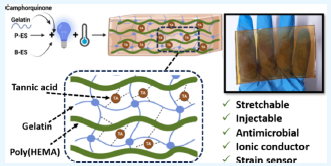619. Tannic Acid-Enhanced Gelatin Double Network Eutectogels Using Polymerizable Eutectic Solvents
Pablo A. Mercadal, Yanet Maribel Martínez, Marianela Zoratti, Manuel Isaac Velasco, Marcelo Ricardo Romero, Guillermina Tommasone, Matias L. Picchio, Agustín González, ACSAppliedPolymerMat, (2025), DOI: 10.1021/acsapm.4c03081
Eutectogels (eGels) have recently emerged as innovative soft ionic materials due to their environmental friendliness, easy preparation, nonvolatility, and good ionic conductivity. Herein, we fabricated double network eGels using gelatin and a ternary polymerizable eutectic solvent (P-ES) composed of 2-hydroxyethyl methacrylate (HEMA), tannic acid (TA), and choline chloride (ChCl) as an effective strategy to enhance the often-limited mechanical properties of eGels, particularly when natural polymers are used. The first poly(HEMA) network was formed by photopolymerizing a mix of P-ES/gelatin under blue-light radiation, followed by the formation of the second protein network upon storage at 4 °C. The double-network eGels were reinforced by TA, which formed strong interactions with both the gelatin and poly(HEMA) networks. This resulted in enhanced mechanical strength, reaching up to 289 kPa at a 50 wt % P-ES concentration. eGels exhibited excellent injectability behavior at 55 °C and adhesive properties on surfaces like glass and plastic, and maintaining adhesion stress values to pigskin after five attachment-detachment cycles. The eGels also demonstrated good ionic conductivity at room temperature (∼3 mS/cm−1) and maintained this performance even at low temperatures. Additionally, they were responsive to flexion movements, effectively simulating the flexibility of human body joints. Finally, P-ES-containing eGels demonstrated strong antimicrobial activity against S. aureus, attributed to TA. These findings present a versatile strategy for enhancing the mechanical and functional properties of hybrid eGels by integrating functional P-ES in natural polymers, paving the way for innovative applications in biomedical devices, wearable technologies, and advanced sensing platforms.
